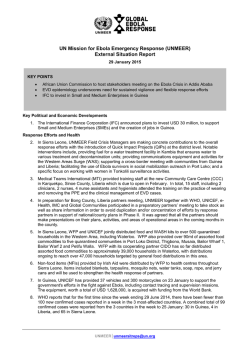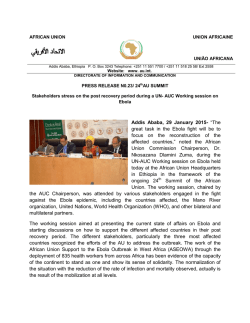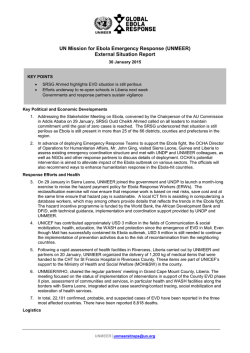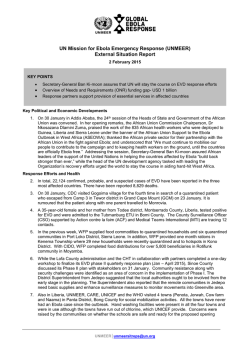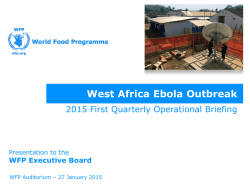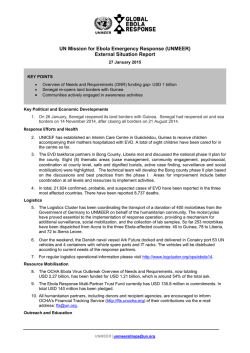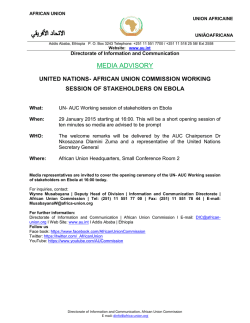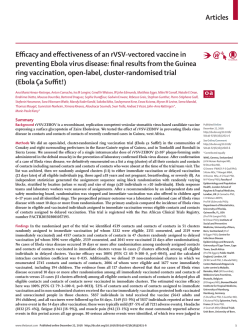
HUMANITARIAN CRISIS IN WEST AFRICA (EBOLA)
HUMANITARIAN CRISIS IN WEST AFRICA (EBOLA) GENDER ALERT: February 2015 TAKING INTO ACCOUNT THE DIFFERENT NEEDS OF WOMEN, GIRLS, BOYS AND MEN MAKES HUMANITARIAN RESPONSE MORE EFFECTIVE AND ACCOUNTABLE TO ALL AFFECTED POPULATIONS. As of 21 January, WHO reports1 the cumulative number of Ebola cases (probable, confirmed and suspected) in the countries with widespread and intense transmission (i.e. Guinea, Liberia and Sierra Leone) stands at 21,689, with 8,626 recorded deaths. This equates to a mortality rate of 39.7%, however it is acknowledged that deaths are underreported. The sex-disaggregated breakdown of the cumulative cases across all three countries as 51% female and 49% male (female cases per country are Guinea 51.7%, Liberia 49% and Sierra Leone 52.3%). In the previous gender alert2 it was noted how cultural and traditional practices in West Africa have the potential to greatly increase the exposure of women to the risk of Ebola (including women’s role as professional health workers, as care-givers in the household and in the preparation of dead bodies for burial). This demonstrated that, irrespective of the male/female ratio of cumulative cases, any strategies to stem the epidemic require a gender nuanced approach that addresses the differing needs, interests and vulnerabilities of the women, men, boys and girls in the affected countries. Now that the rate of infection seems to be stabilizing, more attention is being paid to the wider, socio-economic impact of the crisis which also effects women, men, girls and boys in different ways. To this end, this update of the Gender Alert seeks to highlight the most pressing issues relating to ensuring gender-equality is a central facet in the strategic planning and implementation of the continuing humanitarian response and the transition to recovery. PARTICIPATION AND LEADERSHIP OF WOMEN AND GIRLS The UN Country Team in Sierra Leone launched its Ebola Gender Mainstreaming Strategy in October, in collaboration with UN Women. Similarly, the UNCT in Liberia has approved an Ebola Response Gender Strategy, which is now in the process of being finalized. The strategies calls for women’s participation in the Ebola response, better collection and use of sex disaggregated data, and re-establishing trust in public health services. In addition, the UN, EU and the World Bank - in collaboration with a range of partners including the African Development Bank, the Mano River Union, the ECOWAS and the African Union, are supporting the governments in Guinea, Liberia and Sierra Leone in the undertaking of an Ebola Recovery Assessment (ERA) which includes gender as an issue of focus. Final ERA reports with national short, medium and long term recovery strategies are expected in February/March. The role of women and girls in the post-crisis recovery will be essential to facilitate an expedited normalization of the social and economic landscape. 1 2 WHO – Ebola Situation Report – 21 January 2015 IASC Gender Reference Group – Humanitarian Crisis in West Africa (Ebola) Gender Alert - September 2014 Action Points for Participation and Leadership of Women and Girls: Gender equality and women’s participation should be further integrated throughout the ongoing outbreak management and recovery process at the country and regional level. All coordinating bodies to collect, utilize and disseminate sex- and age-disaggregated data. The ongoing Ebola Recovery Assessment (ERA) must ensure that gender equality concerns are taken into account across the assessment, and that the recovery needs and opportunities for women and girls are explicitly included in the recovery plan with the required budget allocations. Women’s civil society organisations, cooperatives and other associations should be consulted in the planning and implementation of all aspects of the recovery efforts and the participation of women and girls in recovery interventions should be promoted and facilitated. All mass-information campaigns and their materials must be developed in consultation with community representative leaders and experts, including women, so that they include appropriate contextualized and targeted practical messages for women, men, girls and boys. PROGRAMME PRIORITIES TO ENSURE A GENDER-INTEGRATED RESPONSE HEALTH CARE – The primary focus of the outbreak containment strategy has been community mobilization through advocacy and information campaigns. It is essential that all continued Ebola prevention messages take into consideration the distinct needs of women, men, girls and boys - relating to their context and presented in an understandable format. Communities, and in particular women and girls, need to continue to be provided with adequate amounts of the necessary protective materials along with appropriate instructions in their use and disposal. The already fragile health sector capacity in the Ebola crisis affected countries has been overwhelmed. In particular it has been unable to adequately address the needs of women to access maternal health services including delivery and antenatal care. With abandoned health facilities and limitations on people’s movement, pregnant women are now more likely to give birth unattended and forego ante and post-natal care including prevention of maternal to child transmission of HIV, as well being unable to access live saving emergency obstetric and newborn care. It is estimated that in Guinea, Liberia and Sierra Leone, more than 800,000 women will give birth in 2015. Without lifesaving emergency obstetric care, more than 120,000 of these could face complications that might be life-threatening to them and/or their babies3. As an example, reports show the percentage of women in Liberia having assisted deliveries is down from 52% in 2013 to 37.75% in May-August 2014, whilst In Guinea pre-natal consultations have dropped from 25% to 10% and assisted birth deliveries from 20% to 7% over a similar period4. With reduced access to voluntary family planning services adolescent girls and women are at an increased risk of unplanned pregnancies. With the trauma of the Ebola crisis and its aftermath, affected communities and families as well as Ebola survivors continue to be exposed to significant psychological stressors such as the loss of loved ones, loss of livelihoods and resources, fear, social isolation and loss of social networks and supports. With the loss of family members women and children have found themselves taking on the roles and responsibilities as the heads of household or men have had to take on additional child care responsibilities. The closure of schools has been an additional care burden - primarily for women - with their children out of school. These exacerbated sources of stress increase the risk of developing longer-term mental health problems such as depression or anxiety disorders. But with the health and social systems in the affected countries lacking the necessary trained human resources to deal with such problems, the capacity to address this issue is severely lacking.5 3 UNFPA – Ebola Outbreak Response in West Africa - November 2014 UNFPA Country Assessments 2014 5 International Medical Corps - Sierra Leone - Assessment of Mental Health and Psychosocial Support Needs in the Context of Ebola - 2014 4 Action Points for Health Care: For gender-equality programming action points related to disease control and community mobilization, please refer to the September 2014 Ebola Gender Alert.6 Vigilance against a repeat escalation - or future outbreak - of the disease (or any other similarly highly infectious virus) must incorporate the lessons learned on the significance of gender in the spread and control The health care system must ensure the provision of comprehensive sexual and reproductive health services – initially to the to the Minimum Initial Service Package (MISP) standard7 - with the repositioning of health care workers and the reestablishment of health services/facilities that were abandoned. This will provide the starting point for re-establishing and further developing reproductive health care programming during the recovery process and beyond. The health care system must ensure the continuity of family planning services to address any potential rise in unwanted pregnancies. Escalated condom distribution for the prevention of Ebola transmission by male survivors of Ebola as well as HIV and other STDs. Male survivors must be encouraged to use condoms for at least 3 months after recovery – awareness raising on this point should be conducted for women as well. The health care response must develop adequate guidance for precautionary measures for healthcare workers in non-Ebola treatment health facilities. Capacity must be developed in the health-care and social systems in the crisis countries to address the potential longer term post-traumatic stress and other mental health issues of the affected population. WASH AND NON-FOOD ITEMS (NFI) – The adequate supply of dignity kits, sanitary materials, soap and preventative cleaning products, as referenced in the first Gender Alert, are still a key concern. Distribution of and access to these materials, as well as information and facilities for their proper use and safe disposal must be strengthened. Action Points for Non-Food Items and Shelter: The provision of NFI must include adequate supplies and dispersal of dignity kits, sanitary materials and other materials related to reproductive health to communities and households affected by Ebola, as well as treatment centres. Distributions should happen at times and places convenient to women. Distribution should be accompanied with sensitization on the safe disposal of sanitary materials to counter potential increased stigma around menstruation. Information through health promotion – coupled with soap distribution and cleaning products - on the control of EVD through adequate WASH facilities, hand washing and proper human waste disposal should have specific messages for women, men, girls and boys. Dignity for patients attending treatment centres and isolation units must be maintained - particularly for women and girls with separate ablutions, toilets and privacy screens as well as safe disposal bins for used sanitary items. FOOD SECURITY AND LIVELIHOODS – The Ebola crisis is having a signficant impact on the livelihoods of the affected populations, their purchasing power and their ability to fend for themselves. With market closures, closed borders and reduced agricultrual production, rising prices are more pronounced on food items than on non-food items – for example in Sierra Leone, whilst the cost of food items rose by approximately 20%, non essential non-food items (excluding fuel) fell by over 25%8 . As a consequence, levels of food insecurity are rising. This is especially true amongst the rural poor and in particular female- and child-headed households, who often face additional constraints in rural areas due to their limited access to resources and services. 6 IASC Gender Reference Group – Humanitarian Crisis in West Africa (Ebola) Gender Alert - September 2014 Inter-agency Working Group on Reproductive Health in Crises - What is the MISP and why is it important? 2009 8 UNDP – Africa Policy Note – Vol.1 No.4, November 2014 7 Agricultural income for small holder farmers (predominantly women) has been seriously impacted through restriction of movement and lack of access to markets. Cross-border traders (70% women in the Mano-River Union region) and artisanal and small scale extractive miners (it is estimated women make up 40% of the small scale mining workforce across Africa) cannot ply their trade as borders remain sealed. Informal loan schemes, which are the main sources of credit for those employed in the informal sector are being depeleted as the participants find themselves having to use their business capital and savings as a strategy to coping with the hardship imposed by the crisis9. In addition, the majority of Ebola victims are aged between 15-45 years old which is the age group of the main income providers of most families. Such reductions in household incomes coupled with the already observed food price rises will lead to a further deterioration of food security amongst the crisis affected populations. Enhanced economic opportunities, including jobs and livelihoods, through adapted strategies, are vital to redevelop the productive capacity of the affected populations. As well as agriculture and food security focused interventions, additional strategic actions which include a specific focus on faciliating the access and participation of women should include equal access to i) livelihoods stabilization through emergency employment, including non-traditionally female employment, start-up packs and grants to revitalize new and existing enterprises; ii) support for local economic revitalization through small, micro and medium enterprise development, vocational training, socioeconomic infrastructure rehabilitation; and iii) long-term employment creation and inclusive growth10. Consideration must also be made for the food security and livelihood opportunities of women and girl survivors of the disease who may find themselves stigmatised and isolated from their communities. Action Points for Food Security and Livelihoods: The food security and livelihood response must assess and target the specific needs and priorities of affected women, men, girls and boys in rural areas. The food security and livelihood response must ensure women are consulted in the development of economic and livelihood recovery strategies and pogrammes. Women must be given the opportunity to participate not only as beneficiraies but also as leaders and decision makers. The food security response and livelihood orientated agencies must ensure that women and female headed households are specifically targeted in post-crisis economic recovery efforts such as the distribution of agricultural seeds, livestock and tool distributions, value-chain development, entrepreneurial and skills development programmes etc. This should Include supporting women’s access to empolyment opportunities which challenge traditional gender roles. Legitimate credit schemes, cooperatives and loan systems affected by the crisis should be provided with initial financial support and training opportunities to ensure their renewed viability and future prospects. Particular focus should be paid to women’s access to credit and financial products. Border closures should be cancelled as soon as feasibly possible to allow immediate resumption of crossborder trading and access to markets. The private sector – including the extractive industries – should be encouraged to re-establish their operations and the rehiring of local employees as soon as it is feasible. Survivors of Ebola and GBV should be supported in the access to livelihood opportunities as part of the recovery efforts. The food security response must assess, redevelop and protect local institutional infrastructure (eg. women’s and farmers’ associations, cooperatives, savings and loan schemes, local government structures etc) and strengthen the access of vulnerable men and women to existing services and information. 9 UNDP – Africa Policy Note – Vol.1 No.5, November 2014 UNDP – Assessing the Socio-Economic Impact of the Ebola Virus Disease in Guinea, Liberia and Sierra Leone, the Road to Recovery, December 2014 10 Constraints on women’s independence, time, mobility and security that may impede their participation in interventions should be taken into account in design of recovery interventions to facilitate women’s equal access. PROTECTION - The continued disruptive impact on normal legal, social and policing structures means that security, justice and social services have been severly curtailed, leaving limited avenues to justice for survivors of GBV. In addition, with many health services abandoned or severly disrupted, the ability of survivors to access essential treatment remains restricted. Women and girls are particularly vulnerable in such an environment. Households are left unprotected with adult members incapacitated and/or in treatment. Displaced women and girls are vulnerable to sexual expolitation and abuse. Survivors can be stigmatised and isolated from the support of their communities and left with no means of shelter and livelihood. In addition, orphaned children and young boys and girls are at particular risk by being shunned from their community and leaving them vulnerable to exploitation and abuse without a lack of income or adult support. With schools closed as a preventative measure since last June, children’s education has been severely disrupted in the crisis affected countries with 5 million school aged children denied access to educational opportunities. The educational indicators in the region were already a concern before the outbreak, especially for girls (e.g. in Sierra Leone only 50% of 15-24 females are literate, compared to 69% males ), so this suspension of formal education is likely to have a significant impact on the educational choices for many girls and will lead to an escalation of drop-outs who will not resume their studies when schools reopen. Now that schools are scheduled to reopen in Guinea and similar moves are being planned for Sierra Leone and Liberia, it is essential that girls are specifically targeted to encourage their return. In addition, it is vital that appropriate preventative measures are in place to minimize the risk of further outbreaks of Ebola through school environments . On a positive note, there is anecdotal evidence that FGM has drastically reduced in Sierra Leone. With the official banning and the reluctance of the circumcisers to carry out FGM there is an opportunity to build the anti-FGM momentum in Sierra Leone with educational and informative programmes on the positive aspects of not returning to this practice. Action Points for Protection: • The protection response must aim at reducing emerging protection threats and vulnerabilities associated with humanitarian assistance and the “do no harm” approach must be emphasised. • The protection response must identify gaps in GBV survivor-service provision and to provide essential stop gap measures where feasible. This especially applies to quarantined areas. • Normal legal, social-welfare and policing structures should be re-established nationwide as soon as possible to ensure an official level of protection is in place and the resumption of law and order. • As per the recent Guinea intitaive, Liberia and Sierra Leone should reopen their schools as soon as feasibly possible. Specific focus should be paid to incentivising girls to return to school. • The protection response must endeavour to prevent family separation, including the provision alternative care arrangements to preserve as much as possible family unity (e.g. keeping siblings together). • The protection response must develop community mobilisation and support – with opportunities for women’s equal participation and leadership - to counter Ebola-survivor stigmatisation and to assist in their reintegration into their communities, households and schools. • The protection response must pay close attention to the protection needs of women and girls in Ebola affected communities, building on the strengths and capacities of existing women’s and girls groups. • The protection response should build on the anti-FGM momentum in Sierra Leone with educational and informative programmes on the positive aspects of not returning to this practice. • • • It is essential that for women survivors engaged as caregivers their pay and entitlements are in place to minimize the risk of exploitation. Agencies providing psychosocial support must also assist those who are caring for orphaned children. Preventive efforts, to reverse the increase in GBV cases as a consequense of the Ebola crisis, must be prioritized, including targeting men and boys through information campaigns ASSESSMENT AND PLANNING – Needs assessments and the development and design of programming must prioritise the collection, analysis and use of sex-and age-disaggregated data and gender-responsive consultations with women, girls, boys and men. For more details, please refer to the ADAPT an ACT-C Framework for gender programming found in the IASC Gender Handbook for Humanitarian Action – English Version http://www.humanitarianinfo.org/iasc/documents/subsidi/tf_gender/IASC%20Gender%20Handbook%20%28Feb%2 02007%29.pdf. French version: http://www.humanitarianinfo.org/iasc/downloaddoc.aspx?docID=4974&type=pdf FOR MORE INFORMATION AND TECHNICAL SUPPORT, please contact the secretariat of the Gender Reference Group at [email protected]
© Copyright 2025
